Content for Unidades A and B
Unidade 1 – Parte A – Apresentações
Eduardo Viana da Silva

By the end of this lesson, you will be able to:
- Greet people
- Introduce yourself in Portuguese.
- Say the alphabet in Portuguese.
- List the days of the week and the months.
- Say where you are from and where you live.
- List numbers from 1 to 31.
- Name objects in the classroom.
1 – Apresentações

| Conversa 1 A – Prazer, Pedro. – It’s a pleasure, Pedro. B – Muito prazer, Maria – It’s a pleasure, Maria. |
Conversa 2 A – Prazer, Maria. Como é o seu nome? – A pleasure, Maria. What’s your name? B – Meu nome é Pedro. Muito prazer. – My name is Pedro. It’s a pleasure. |
Aquecimento – Warm-up
Stand up and introduce yourself to someone in the class using the model above. Shake hands and give your name (Prazer, your name/ It’s a pleasure).
O Alfabeto
Repeat the alphabet after your instructor
| A – á B – bê C – cê D – dê E – é F – éfe G – gê H – agá |
I – i J – jota K – ká L – ele M – eme N – ene O – ó P – pê Q – quê |
R – erre S – esse T – tê U – u V – vê W – dabliu X – xis Y – ípslon Z – zê |
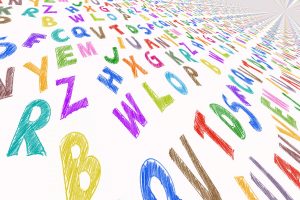 |
Letra maiúscula: Capital letter
Letra minúscula: Lower case letter
| 1.1 – Escreva seu nome (first name) e sobrenome (last name). Write your name and last name below. | |
|---|---|
| Nome: | Sobrenome: |
| 1.2 – Em pares (In pairs) | |
|---|---|
| Como se escreve seu nome e sobrenome?
How do you write your name and last name? Listen to your colleague spell her/his first and last names and write them in the spaces below. |
|
| Nome:
|
Sobrenome:
|
2 – Saudações – Greetings
|
bom dia  |
boa tarde  |
boa noite  |
SAuDAÇÕes informais – Informal Greetings
| A – Oi tudo bem? Hi, is everything going well? B – Tudo, e você? All is well, and you? A – Tudo bom. All good. |
A – E aí? What’s up? B – Tudo bem, e você? All is well, and you? A – Tudo joia. Everything’s great. |
A – Beleza? Great B – Beleza Great |
CONVERSA – E AÍ CYNTHIA?
Two students greeting each other at UNESP – Universidade Estadual Paulista in the city of Araraquara – State of São Paulo – Brazil
A: E aí Cynthia? – What’s up, Cynthia?
B: Oi Felipe, tudo bem? – Hi Felipe, all well (good)?
A: Tudo certo e você?– All good (all right), and you?
B: Tudo certo também – All good too.
Aquecimento – Warm-up

| 2.1 – Using the informal greetings above, talk to 2 or 3 classmates in class. Write their names in the space below: | ||
|---|---|---|
| Estudante 1
|
Estudante 2
|
Estudante 3
|
SAUDAÇÕES formais – Formal Greetings
| A – Olá, tudo bem? B – Tudo bem, e a senhora? A – Tudo bem, obrigada. |
A – Bom dia, como a senhora vai? – Good morning, how are you ma’am? B – Muito bem, e o senhor? – Very well, and you sir? A – Muito bem, obrigado. – Very well, thank you. |
Aquecimento – Warm-up
| 2.2 – Using the formal greetings, talk to 2 or 3 classmates in class. Writer their names in the space below: | ||
|---|---|---|
| Formal: Como é o nome da senhora?/ Como é o nome do senhor? | ||
| Estudante 1
|
Estudante 2
|
Estudante 3
|
Click here for an explanation of the formal and informal “you” in Brazilian Portuguese.
saudaçÕES – Greetings

| Obrigada/o/e – Thank you De nada – You’re welcome Tchau – Bye |
Desculpa – Sorry Com licença – Excuse me Até amanhã – Until tomorrow |
Valeu – Thank you/ Deal Beleza – Awesome Legal – Cool |
| Write the greetings above that correspond to the emojis below: | ||
|---|---|---|
3 – A Semana e os Meses do Ano
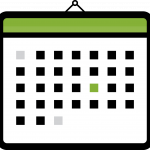
| dias da semana days of the week |
segunda-feira – Monday terça-feira – Tuesday quarta-feira – Wednesday |
quinta-feira – Thursday sexta-feira – Friday |
| fim de semana weekends |
sábado – Saturday | domingo – Sunday |
| meses do ano months of the year |
janeiro fevereiro março abril |
maio junho julho agosto |
setembro outubro novembro dezembro |
| 3.1 – Escreva: (Write) | |||
|---|---|---|---|
| Hoje é (Today is) | (dia da semana) | (data) de | (mês) |
A – Aquecimento – Warm-up
| 3.2 – Answer the following questions in Portuguese: |
|---|
| Qual é o seu dia favorito da semana? / What’s your favorite day of the week? |
| Qual é o seu mês favorito do ano? / What’s your favorite month of the year? |
| Qual mês é o seu aniversário? / What month is your birthday? |
| Qual dia da semana é hoje? / What day of the week is today? |
Em pares (In Pairs)
| 3.4 – Compare the answers above with a colleague in class and write your colleague’s answer: |
|---|
| O dia favorito da semana / favorite day of the week |
| O mês favorito do ano/ favorite month of the year: |
| O mês de aniversário / month of birthday: |
| 3.5 – Write the months that correspond to the holidays below. | |
|---|---|
Natal – Christmas
 |
Dia das Bruxas – Halloween
 |
Dia dos Namorados – Valentine’s Day
 |
Dia da Independência – Independence Day

|
Ramadan
 |
4 – CONVERSA 1 – DE ONDE VOCÊ É? – Where are you from?

Verbo ser – Verb to be
| Eu sou – I am | A gente é / Nós somos – We are |
| Tu és – You are | |
| Ela/Ele/Elu/Você é – She/He is, They/You are | Elas/Eles/Elus/Vocês são – They/You are |
Conversa – De onde você é? / Where are you from?
 |
 |
Pedro: Oi, tudo bem?
Maria: Tudo, e você?
Pedro: Tudo jóia. De onde você é?
Maria: Eu sou dos Estados Unidos, e você?
Pedro: Sou do Brasil.
Maria: De que parte do Brasil?
Pedro: Do Rio de Janeiro. E você?
Maria: Eu sou da cidade de Nova Iorque.
| Glossary: | Grammar: Contractions |
|---|---|
| cidade: city e = and é = is |
de + o = do de + a = da de/do/da = from |
| 4.1 – Comprehension questions. Write “V” for Verdadeiro (True), “F” for Falso, ou “FI” for Falta de informação (missing information) |
|---|
| a – ( ) Pedro is from São Paulo. b – ( ) Maria is an American. c – ( ) Pedro is Brazilian. d – ( ) Maria likes New York. |
| de | do (de + o) | da (de + a) |
|---|---|---|
| de Portugal de Moçambique de Cuba de Israel |
do Canadá dos Estados Unidos dos Açores do México do Brasil |
da Austrália da Alemanha da Inglaterra das Ilhas Canárias da França |
| de | de | do (de + o)/ da (de + a) |
|---|---|---|
| de Lisboa de Nova Iorque de Seattle de São Paulo de São Francisco de Miami |
de Provo de Salvador da Bahia de Recife de Manaus de Chicago. de Maputo |
do Rio de Janeiro |
Aquecimento – Warm-up
|
4.2 – O que você acha? – What do you think?
Exemplo: Pelé é do Brasil. |
||
|---|---|---|
Obama

Rainha Elizabeth 
Frida Kahlo  |
Coco Chanel 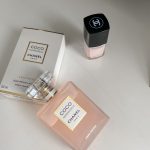 Photo by Анастасия pexels.com
Cristiano Ronaldo  pixabay.com
|
Brasil
Estados Unidos
Portugal
México
França
Inglaterra |
| 4.3 – Answer the following questions in a complete sentence: |
|---|
| a – Qual é o seu nome? |
| b – De onde você é? |

| 4.4 – Atividades para caminhar na sala. Activities to walk around in class. Talk to classmates in Portuguese and ask the questions below. | |
|---|---|
| Como é o seu nome? | De onde você é? |
| Expressões Importantes de Surpresa | |
|---|---|
| Que legal! – How cool! Massa! – Great! Super legal! – Super cool! |
Eu também! – Me too! Mesmo? – Really? Nossa! – Wow! |
5 – PodCast – Língua da Gente – VocÊ vem de onde paulo?
| Você vem de onde Paulo?/ Where do you come from Paulo? |
|
|---|---|
| A: Você vem de onde Paulo? B: Aqui do Rio e você? A: Eu sou de Brasília. B: Hum, dizem que o céu lá é enorme, não é? Source: Brazil Pod: Língua da Gente – COERLL – University of Texas, Austin |

|
Click here for the full podcast.
| vem – come aqui – here |
dizem que – (they/people) say céu – sky in this context/ heaven in other contexts |
lá – there não é? – isn’t it? (short version: né?) |
| 5.1 – Comprehension questions. Choose “V” for Verdadeiro (True), “F” for Falso, ou “FI” for Falta de informação (missing information). |
|---|
| a – ( ) Paulo lives in Brasília. b – ( ) Paulo is from Rio de Janeiro. c – ( ) Paulo and the the woman are a couple. d – ( )The woman is from Brasília. |
6 – Conversa 2 – ONde Você mora? /Where do you live?
| Pedro: Onde você mora em Nova Iorque? Maria: Moro no Brooklyn, e você? Pedro: Moro em Copacabana, no Rio. Maria: Que legal! É uma praia famosa. Pedro: É mesmo! Maria: Você mora numa casa ou num apartamento? Pedro: Em um apartamento. E você? Maria: Eu também moro num apartamento. |
 |
 |
| Glossary: | Contractions: | |
| praia: beach mora: to live |
em (in/at) em + o = no em + a = na |
em + um = num em + uma = numa |
| 6.1 – Comprehension questions. Choose “V” for Verdadeiro (True), “F” for Falso, ou “FI” for Falta de informação (missing information). |
|---|
| a – ( ) Pedro mora numa praia. b – ( ) Maria mora em Nova Iorque. c – ( ) Pedro mora numa casa. d – ( ) Maria mora num apartamento. |
| em | no (em + o) | na (em + a) |
|---|---|---|
| em Portugal em Moçambique em Cuba |
no Canadá nos Estados Unidos nos Açores no México no Brasil |
na Austrália na Alemanha na Inglaterra nas Ilhas Canárias na França |
| em | em | no (em + o)/ na (em + a) |
|---|---|---|
| em Lisboa em Nova Iorque em Seattle em São Paulo em São Francisco em Miami |
em Provo em Salvador da Bahia em Recife em Manaus em Chicago em Maputo |
no Rio de Janeiro |
Verbo MORAR – to live
| Eu moro – I live | A gente mora / Nós moramos – We live |
| Tu moras – You live | |
| Ela/Ele/Elu/Você mora – She/He lives, They/You live | Elas/Eles/Elus/Vocês moram – They/You live |
Morar is a regular verb, meaning that its root (mor) does not change in any person or tense. Regular verbs finishing in AR correspond to most of the verbs in Portuguese (around 80%). Pay attention to the highlight above (o, as, a – a, amos, am).*Be careful not to write “Eu mora” The verb “morar” does not agree with the gender of the person. It is always: “Eu moro…”
| 6.2 – Answer the following questions with a complete sentence: |
|---|
| a – Onde você mora? Em que bairro (neighborhood)? |
| b – Você mora numa casa ou num apartamento? |
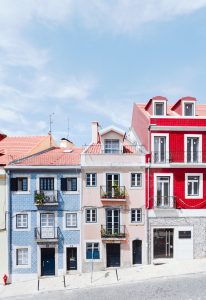
Photo by Hugo Sousa on Unsplash.com
| 6.3 – Atividades para caminhar na sala. Activities to walk around in class. Talk to classmates in Portuguese and ask the questions below. | ||
|---|---|---|
| Qual é o seu nome? | Em que bairro você mora? | Você mora numa casa ou num apartamento? |
7 – Números
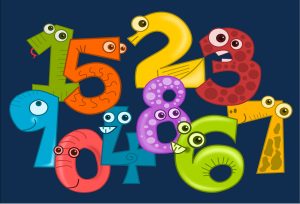
| 0 – zero 1 – um/uma 2 – dois/duas 3 – três 4 – quatro 5 – cinco 6 – seis 7 – sete 8 – oito 9 – nove 10 – dez |
11 – onze 12 – doze 13 – treze 14 – catorze 15 – quinze 16 – dezesseis 17 – dezessete 18 – dezoito 19 – dezenove 20 – vinte |
21 – vinte e um 22 – vinte e dois 23 – vinte e três 24 – vinte e quatro 25 – vinte e cinco 26 – vinte e seis 27 – vinte e sete 28 – vinte e oito 29 – vinte e nove 30 – trinta 31 – trinta e um |
| 7.1 – Responda as perguntas abaixo: |
|---|
| a – Que dia do mês é hoje? |
| b – Quantos estudantes tem aproximadamente em sua sala de aula? |
| c – Quantas aulas você tem? |
| d – Quantos anos você tem? |
| e – Quantos irmãos (siblings) você tem? |
7.2 – BINGO. Circle the numbers that your instructor dictates. Say “BINGO” when you complete a row of five numbers.
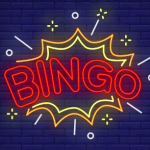
Katemangostar on freepik.com
| 5 | 15 | 21 | 16 | 28 |
| 1 | 8 | 26 | 13 | 22 |
| 31 | 14 | Livre | 22 | 25 |
| 27 | 17 | 14 | 10 | 12 |
| 30 | 31 | 7 | 11 | 9 |
| 4 | 26 | 31 | 7 | 30 |
| 29 | 14 | 23 | 13 | 19 |
| 16 | 28 | Livre | 15 | 31 |
| 12 | 24 | 17 | 18 | 9 |
| 22 | 8 | 5 | 11 | 14 |
| 5 | 15 | 21 | 16 | 28 |
| 0 | 7 | 26 | 18 | 22 |
| 31 | 14 | Livre | 21 | 25 |
| 28 | 31 | 14 | 11 | 12 |
| 30 | 20 | 7 | 10 | 9 |
| 3 | 25 | 31 | 6 | 30 |
| 28 | 14 | 23 | 13 | 18 |
| 16 | 28 | Livre | 15 | 30 |
| 12 | 24 | 17 | 18 | 9 |
| 21 | 8 | 4 | 11 | 15 |
| 5 | 15 | 20 | 16 | 27 |
| 1 | 8 | 26 | 13 | 22 |
| 30 | 18 | Livre | 22 | 25 |
| 23 | 16 | 14 | 10 | 12 |
| 30 | 31 | 7 | 13 | 8 |
| 7 | 26 | 31 | 4 | 30 |
| 25 | 13 | 22 | 13 | 19 |
| 16 | 27 | Livre | 15 | 31 |
| 12 | 24 | 17 | 18 | 9 |
| 23 | 8 | 5 | 0 | 14 |
| 7.3 – Em pares (In pairs) Student A – Dictate the numbers below to a classmate. 15 28 31 13 3 6 Now, listen to the numbers being dictated by your classmate and write them in the box below. |
|---|
| 7.4 – Em pares (In pairs) Student B – Dictate the numbers below to a classmate. 22 30 17 29 2 10 Now, listen to the numbers being dictated by your classmate and write them in the box below. |
|---|
| 7.5 – Quando é o seu aniversário? – When is your birthday? E.g. É no dia 21 de abril. |
|---|
| 7.6 – Find someone in class that has a birthday date close to yours. Quando é o seu aniversário? |
|
|---|---|
| Nome: | Nome: |
| Data de aniversário: | Data de aniversário: |
| Nome: | Nome: |
| Data de aniversário: | Data de aniversário: |
Parabéns pra você
Parabéns pra você! Nessa data querida.
Muitas felicidades. Muitos anos de vida.
Parabéns pra você! Nessa data querida.
Muitas felicidades. Muitos anos de vida.
8 –A Sala dE Aula – The Classroom

| a porta – the door a janela – the window o chão – the floor o teto – the ceiling a parede – the wall o quadro – the board o apagador – the blackboard/dry eraser a mesa – the table a cadeira – the chair o computador a televisão |
o relógio – the clock o projetor – the projector a carteira – the desk a tela – the screen o livro – the book a caneta – the pen o lápis – the pencil o apontador – the pencil sharpener o estojo – the pencil case a pasta – the binder a borracha – the eraser |
When counting items in a classroom, the numbers 1 and 2 need to agree in gender with the object, as in the examples below:chair = (1) uma cadeira, (2) duas cadeiras, (3) três cadeiras, (4) quatro cadeiras
board = (1) um quadro, (2) dois quadros, (3) três quadros, (4) quatro quadros
| 8.1 – Quantos objetos tem na sala?
How many objects are in the classroom? e.g. Quantas portas tem (are there) na sala? Tem duas portas. |
|---|
a – Quantos relógios tem na sala?
 |
d – Quantas janelas tem na sala?
 |
b – Quantas mesas tem na sala?
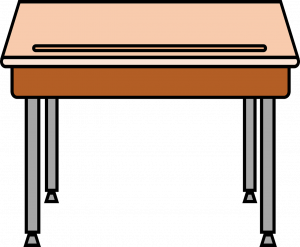 |
e – Quantos projetores tem na sala?
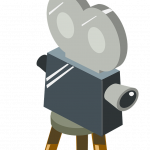 |
c – Quantas portas tem na sala?
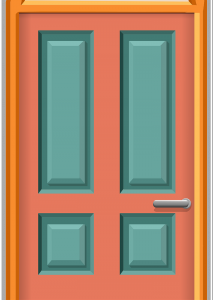 |
f – Quantas televisões tem na sala?
 |
| 8.2 – Em pares (In pairs) Ask the questions below to a classmate |
|---|
| a – Quantas portas tem na sua casa? |
| b – Quantas mesas tem na sua casa? |
| c – Quantas televisões tem na sua casa? |
| d – Quantos computadores tem na sua casa? |
Meu carro (My car) Minhe amigue. (My friend)
Minha casa (My house)
Verbo TER
Verbo ter – to have (there is – tem)
| Eu tenho | A gente tem /Nós temos |
| Tu tens | |
| Ela/Ele/Elu/Você tem | Elas/Eles/Elus/Vocês têm |
| 8.3 – Responda – Answer: e.g. Quantos relógios você tem? Eu tenho um relógio./ Eu não tenho nenhum relógio. |
|---|
| a – Quantas canetas você tem? |
| b – Quantas bicicletas você tem? |
| c – Quantos livros você tem? |
| d – Quantos computadores você tem? |
*Attention – the word “any” in Portuguese has the masculine form (nenhum) and the feminine form (nenhuma)
Exemplo:
Não tenho nenhum relógio.
Não tenho nenhuma bicicleta.
| 8.4 – Atividade para caminhar na sala. Talk to several classmates to see who has more of the items below. Write the number of items and the name of the classmate with the most items. | ||
|---|---|---|
| Nome do colega | Objeto | Número de objetos |
| livros | ||
| bicicletas | ||
| canetas | ||
| borrachas | ||
9 – LEITURA – A SALA DE AULA IDEAL – The ideal classroom
| Em pares – In pairs
9.1 – Escolha o que é mais importante na sala de aula. Marque 1 para mais importante e 6 para menos importante. |
|---|
| ( ) carteiras ( ) canetas |
| ( ) quadro ( ) apagadores |
| ( ) projetor ( ) computador |
A SALA DE AULA IDEAL
A sala de aula ideal tem muitos objetos e equipamentos. A sala de aula ideal tem carteiras confortáveis, mais ou menos 20 carteiras. Tem também um relógio de parede, pelo menos duas janelas grandes e uma porta grande.

A sala temtambém um computador para a professora/x/o e um projetor.É importante ter um ou dois quadros e dois apagadores, além de canetas e outros materiais. O acesso à Internet é muito importante também! A sala precisa ter uma mesa e uma cadeira para a professora/o professor.
| mais ou menos – more or less pelo menos – at least |
grande(s) – big além – besides precisa ter – needs to have |
| 9.2 – Em pares. Marque as opções com Verdadeiro ou Falso de acordo com o texto acima. Mark the options as True or False according to the text above. |
||
|---|---|---|
| a – The ideal classroom has much more than 20 desks. | ( ) Verdadeiro | ( ) Falso |
| b – The ideal classroom has a large wall clock. | ( ) Verdadeiro | ( ) Falso |
| c – It has a computer for each student. | ( ) Verdadeiro | ( ) Falso |
| d – It needs to have a table for the teacher. | ( ) Verdadeiro | ( ) Falso |
Can-Do Statements

Photo by Clay Banks on unsplash.com.
| I can | Fully | Minimally | No ability |
|---|---|---|---|
| greet people. | |||
| introduce myself in Portuguese. | |||
| say the alphabet in Portuguese. | |||
| say where I am from and where I live. | |||
| list the days of the week and the months. | |||
| list the numbers from 1 to 31. | |||
| name objects in the classroom. |
VOCABULÁRIO
| INFORMAL GREETINGS Oi tudo bem? – Hi, is everything going well? Tudo bom – All good E aí? – What’s up? Tudo jóia – Everything’s great. GREETINGS Obrigada/o – Thank you Desculpa – Sorry Valeu – Thank you/ Deal De nada – You’re welcome Com licença – Excuse me Beleza – Awesome Tchau – Bye Até amanhã – Until tomorrow Legal – Cool FORMAL GREETINGS Bom dia, como a senhora vai? – Good morning, how are you ma’am? Muito bem, e o senhor? – Very well, and you sir? MORE GREETINGS Bom dia – Good morning Boa tarde – Good afternoon Boa noite – Good night |
| Days of the Week |
|---|
| segunda-feira – Monday terça-feira – Tuesday quarta-feira – Wednesday quinta-feira – Thursday sexta-feira – Friday sábado – Saturday domingo – Sunday |
| Months of the Year | Numbers | ||
|---|---|---|---|
| janeiro fevereiro março abril maio junho julho agosto setembro outubro novembro dezembro |
0 – zero 1 – um/uma 2 – dois/duas 3 – três 4 – quatro 5 – cinco 6 – seis 7 – sete 8 – oito 9 – nove 10 – dez |
11 – onze 12 – doze 13 – treze 14 – catorze 15 – quinze 16 – dezesseis 17 – dezessete 18 – dezoito 19 – dezenove 20 – vinte |
21 – vinte e um 22 – vinte e dois 23 – vinte e três 24 – vinte e quatro 25 – vinte e cinco 26 – vinte e seis 27 – vinte e sete 28 – vinte e oito 29 – vinte e nove 30 – trinta 31 – trinta e um |
| Classroom | |
|---|---|
| a porta – the door a janela – the window o chão – the floor o teto – the ceiling a parede – the wall o quadro – the board o apagador – the blackboard/dry eraser a mesa – the table a cadeira – the chair o computador a televisão |
o relógio – the clock a carteira – the desk a tela – the screen o livro – the book a caneta – the pen o lápis – the pencil o apontador – the pencil sharpener o estojo – the pencil case a pasta – the binder o projetor |
| Verbos | Questions |
|---|---|
| achar – to think/ to believe ditar – to dictate escrever – to write morar – to live ser – to be ter – to have |
Como? – How? Onde? – Where? Quando? – When? Quanto?/ Quanta? – How much? Quantos? / Quantas? – How many? Qual? Que? – What? |
and
is
city
come
here
they/people say
sky in this context/heaven in other contexts
there
isn't it?
to live
in/at
em + o
beach
em + uma
em + um
more or less
at least
big
besides
needs to have

